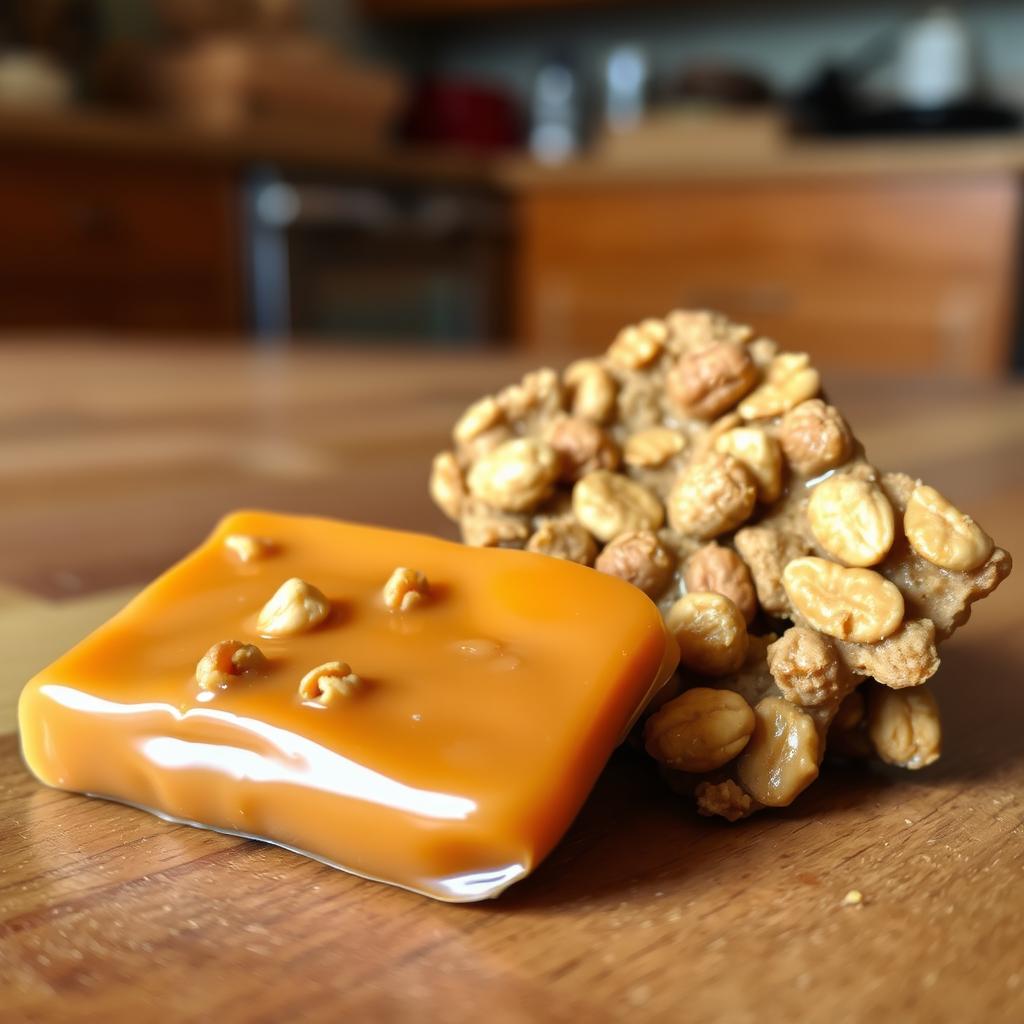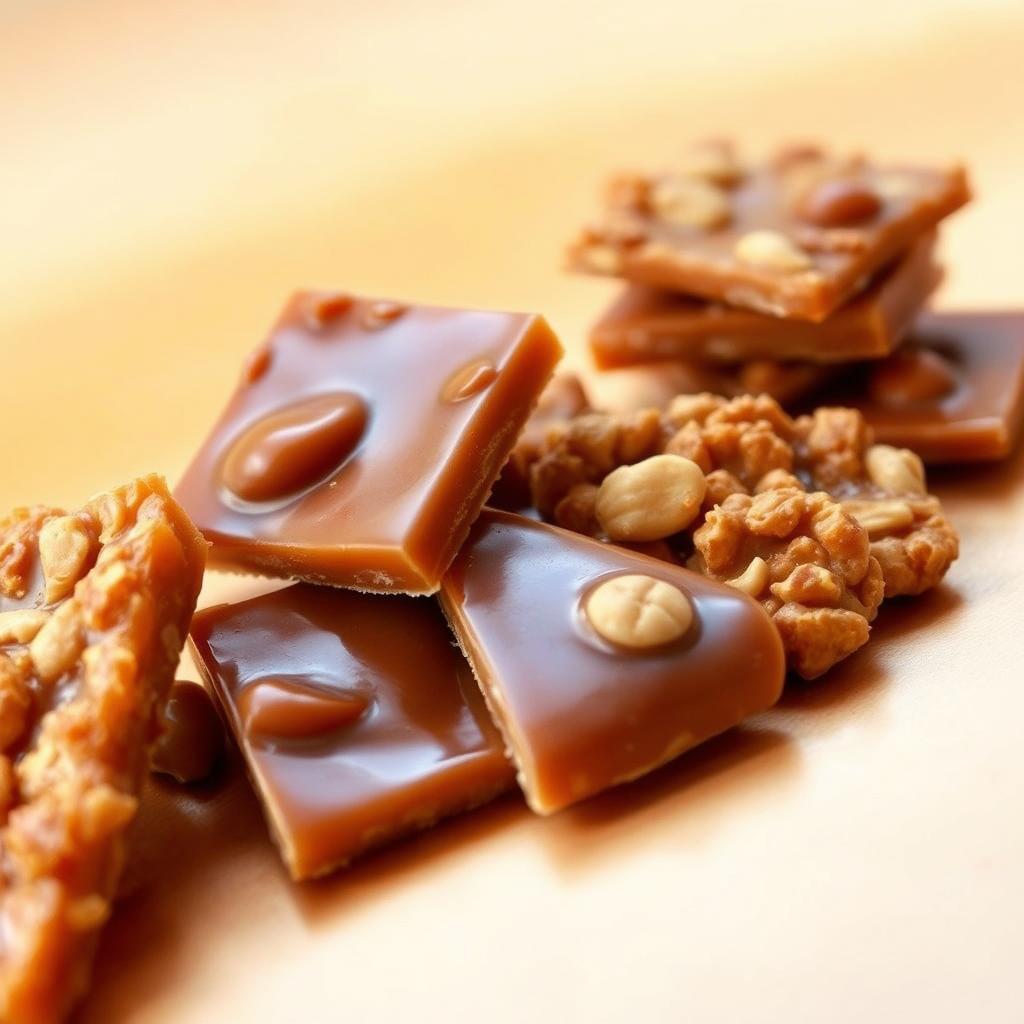What’s the difference between toffee and peanut brittle? I recall the magical moment when my grandmother would open a tin of freshly made toffee. The sweet aroma would fill the air, and each crunchy bite transported me to a world of buttery sweetness and nostalgia.
The crisp snap of peanut brittle also held a special place in my heart. It reminded me of festive gatherings where it was a cherished tradition.
As a candy connoisseur, I’ve always been fascinated by the differences between toffee and peanut brittle. Let’s explore the world of candy together. We’ll look at what makes toffee and peanut brittle unique, and uncover their rich histories and culinary science.
Table of Contents

Key Takeaways
- Toffee and peanut brittle have distinct compositions, textures, and visual appeal.
- Toffee originated in the United Kingdom, while peanut brittle is an American classic.
- Cooking temperature and nut selection play crucial roles in the unique flavors and characteristics of each confection.
- Both toffee and peanut brittle offer a satisfying crunch and can be enjoyed as standalone treats or incorporated into various desserts.
- Understanding the differences between these two beloved candies can help you make informed choices and discover new ways to indulge your sweet tooth.
Introduction to Classic Candy Confections
In the world of candy and sweets, toffee and peanut brittle stand out. These classic candy confections have won over many with their unique tastes and textures. Each offers a special experience for the senses.
Toffee is loved for its deep caramel flavor and smooth feel. On the other hand, peanut brittle is known for its crunchy texture and nutty taste. It’s a beloved American treat, loved for its taste and memories it brings back.
Exploring the difference between toffee and peanut brittle, we’ll look at their origins, how they’re made, and the role of nuts. This will help us understand what makes each special.
“Candy is happiness that you can eat.”
Whether you’ve always loved candy or are new to it, discovering toffee and peanut brittle is exciting. It’s a journey that will make your taste buds happy and leave you wanting more. Let’s start our tasty adventure into these candy confections!

What’s the difference between toffee and peanut brittle?
Toffee and peanut brittle are two classic treats. They are loved for their sweet and crunchy qualities. But, they have some key differences.
Basic Composition Differences
Toffee is made by simmering butter and sugar until they caramelize. On the other hand, peanut brittle combines sugar, corn syrup, and roasted peanuts.
Texture and Bite Comparison
Toffee is smooth, dense, and often glossy. It has a satisfying chew. Peanut brittle, however, is known for its crunchy and crisp bite, thanks to the nuts.
Visual Distinctions
Toffee has a golden-brown color. Peanut brittle is lighter and more translucent. The peanuts in it add a unique visual touch.
Knowing these differences helps you enjoy these confections more. It makes choosing a sweet treat easier.

The History and Origins of Toffee Making
The history of candy and sweets like toffee goes back centuries. It shows that making sweets has been a favorite tradition around the world. Toffee, in particular, has a long history that shows its lasting appeal as a favorite candy.
In the 14th century, the Middle East had a sweet treat called “rahat al-hulqum.” It was made by boiling sugar, honey, and nuts or dried fruits. This was an early version of toffee.
- In the 17th century, toffee became popular in Europe. English and Scottish confectioners made it crisp and buttery.
- During the Victorian era, toffee-making grew into a big industry. Shops and street vendors sold it to more people.
- As the British Empire grew, toffee recipes went to colonies like India. There, they made “Kalakand” toffee, a local favorite.
In the 20th century, toffee became more common. Brands and new flavors won over fans worldwide. Today, toffee is still loved, with both makers and home cooks exploring its many uses.
| Era | Toffee Milestones |
|---|---|
| 14th Century | Emergence of “rahat al-hulqum” in the Middle East |
| 17th Century | Toffee gains popularity in Europe, with new techniques developed |
| Victorian Era | Toffee-making becomes a thriving industry with specialty shops |
| 20th Century | Widespread commercialization and innovative flavor combinations |
“Toffee has always been a beloved candy that has stood the test of time, captivating taste buds across cultures and generations.”
Traditional Peanut Brittle: An American Classic
Peanut brittle is a beloved treat that has lasted through the years. It started simple but has become a key part of American food culture. It’s loved across the country, with each region adding its own twist to this classic confection.
Regional Variations
Every part of the country has its own version of peanut brittle. The South loves its buttery, caramelized take. Meanwhile, the Northeast is famous for its light-as-air brittle. Each region has made this sweet its own.
Cultural Significance
Peanut brittle is a big deal in American nuts and candy shops. It shows the country’s love for homemade treats. Its simple yet tasty flavor has made it a favorite for many, bringing people together across the nation.
Holiday Traditions
- Peanut brittle is a big part of many holiday traditions. It’s a favorite for stocking stuffers and hostess gifts.
- Its crunchy texture and sweet taste make it perfect for holidays. It’s great on its own or in holiday treats.
- Sharing peanut brittle is a way to spread joy and connect with family during the holidays.
“Peanut brittle is more than just a candy – it’s a time-honored tradition that brings people together and celebrates the very essence of American confections.”
Base Ingredients and Cooking Methods
The classic candy treats, toffee and peanut brittle, have unique qualities. These come from their base ingredients and cooking methods. Let’s explore what makes these candy treats special.
Toffee is made with sugar, butter, and sometimes salt. The sugar is heated until it caramelizes. Then, butter is added, creating a rich, sweet flavor and a glossy texture.
Peanut brittle, on the other hand, has a more complex mix. It includes sugar and peanuts. The peanuts add a delightful crunch and a nutty taste.
Making peanut brittle involves heating sugar to a higher point. Peanuts are added later. This makes the brittle crisp and crunchy, perfect for snapping.
Toffee and peanut brittle differ in ingredients and cooking. Toffee is smooth and buttery, while peanut brittle is crunchy and nutty. Both are candy favorites that satisfy sweet cravings.
The Role of Nuts in Both Confections
Nuts are key in making toffee and peanut brittle tasty and textured. The nuts used and how they’re prepared change the taste and feel of these treats.
Nut Selection and Preparation
Toffee often has almonds or pecans, roasted to bring out their flavor. Peanut brittle, on the other hand, uses peanuts, boiled or baked for crunch and sweetness. The nuts’ size and shape also affect the treat’s texture.
Impact on Flavor Profile
The nuts used shape the taste of toffee and peanut brittle. Almonds and pecans give toffee a buttery taste. Peanuts make peanut brittle sweet and slightly salty. Together, they create a delicious mix of flavors.
Nutritional Considerations
- Nuts are full of healthy fats, protein, and vitamins and minerals.
- The type of nut can change the confection’s nutritional value, with some being better than others.
- It’s important to eat these treats in moderation because they can be high in calories and sugar.
| Nutrient | Almonds (1 oz) | Pecans (1 oz) | Peanuts (1 oz) |
|---|---|---|---|
| Calories | 160 | 196 | 170 |
| Total Fat (g) | 14 | 20 | 14 |
| Protein (g) | 6 | 3 | 7 |
| Fiber (g) | 3.5 | 2.7 | 2.4 |
Knowing how nuts are used in toffee and peanut brittle helps us enjoy these treats more. It lets us see the differences between them and choose wisely when we indulge.
Temperature Control and Candy Making Science
Making delicious candy, sweets, and caramel needs precise temperature control. The science of candy making is all about balance. Small changes in temperature can greatly affect the texture and feel of your treats.
To make perfect toffee or peanut brittle, you must learn to control temperature. Each step in candy making, from cooking to cooling, needs careful watching and adjusting. This ensures you get the results you want.
- Cooking temperature: The temperature you cook the sugar and ingredients at is key. Toffee needs high temperatures, around 300°F to 320°F, for its crisp texture.
- Cooling process: Cooling is just as important as cooking. Peanut brittle must cool quickly at low temperatures to stay crunchy.
- Monitoring with a candy thermometer: A good candy thermometer is vital. It lets you check and adjust the temperature as needed.
| Confection | Ideal Cooking Temperature | Cooling Technique |
|---|---|---|
| Toffee | 300°F to 320°F | Rapid cooling on a flat surface |
| Peanut Brittle | 300°F to 310°F | Rapid cooling on a flat surface |
Understanding temperature control is key to making perfect candy, sweets, and caramel. Mastering this skill will take your treats to new levels of taste.
Storage and Shelf Life Comparison
Proper storage is key for keeping candy, confections, and sweets fresh. Toffee and peanut brittle, two classic treats, need special care. This ensures they stay delicious for as long as they can.
Proper Storage Methods
Toffee needs a cool, dry place to stay fresh. Store it in an airtight container, like a tin or ziplock bag. This keeps moisture and air away. Peanut brittle, however, does best in a slightly warmer spot. Store it in a sealed container at room temperature, away from sunlight or heat.
Signs of Freshness
- Toffee should be firm and glossy. If it’s soft or chewy, it’s too old.
- Peanut brittle should break cleanly without stickiness. If it’s discolored or dull, it’s lost its freshness.
By storing them right and watching for freshness signs, you can enjoy toffee and peanut brittle at their best. Each has its own special texture and taste.
“The secret to preserving the quality of candy and confections lies in understanding their individual storage needs.”
Health and Nutritional Facts
In the world of nuts, candy, and sweets, toffee and peanut brittle have different health effects. Knowing how these treats affect your health can help you choose wisely.
Calorie and Nutrient Breakdown
Toffee and peanut brittle both have a lot of calories. Toffee has 150-200 calories per serving, while peanut brittle has 120-180. But, they have different nutrients:
- Toffee mainly has sugar, butter, and milk solids. It doesn’t offer much nutrition beyond calories.
- Peanut brittle gets its calories from nuts. Nuts are good for protein, healthy fats, and vitamins and minerals.
Potential Health Concerns
The sugar in toffee and peanut brittle is a problem for those with diabetes or who watch their sugar. Toffee also has a lot of saturated fat, which can raise cholesterol if eaten too much.
But, the nuts in peanut brittle are good for your heart and have antioxidants. It’s important to eat these treats in small amounts.
| Nutrient | Toffee (per serving) | Peanut Brittle (per serving) |
|---|---|---|
| Calories | 150-200 | 120-180 |
| Total Fat | 8-12g | 5-10g |
| Saturated Fat | 5-8g | 1-3g |
| Sugar | 15-25g | 10-18g |
| Protein | 1-3g | 3-6g |
Enjoy toffee and peanut brittle in small amounts as part of a healthy diet. They are treats that should be eaten with care for your health and well-being.
Popular Variations and Modern Twists
In the world of candy and confections, toffee and peanut brittle are getting new twists. Chefs and makers are trying out fresh flavors. They’re making these classic treats exciting again.
Contemporary Flavors
Old favorites like vanilla toffee and simple peanut brittle are out. Today, confectioners are adding bold, new ingredients. Think bourbon-infused toffee and peanut brittle with candied orange peel.
These new flavors are for those who love to try new things. They’re perfect for the candy lover looking for something different.
Artisanal Approaches
The confections world is also seeing more artisanal methods. Skilled makers are making small batches of toffee and peanut brittle. They use old techniques but with a modern touch.
This focus on handcrafted quality has led to caramel-based treats with richer flavors. These treats are more complex and truly delightful.

